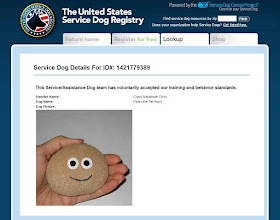Service dogs, emotional support animals, and therapy animals. They all have important jobs to do but their jobs are all very different! There is a lot of misinformation online about them, so we're here to help set the record straight! To start off, here's a good chart to visualize the main differences between the three!

There are a lot of websites out there that say you can register your "service animal" or "emotional support animal", but unfortunately these are all scams that are just looking for people's money. There is no actual certification process for either service dogs or ESAs. Here you can see people have "registered" their pet rocks and raptors from Jurassic Park just to show how much of a scam it really is!

Here are the key differences to remember for the three types of dogs:
- Service dogs: A service dog is defined as a dog that is individually task trained to help an individual with a disability. The tasks that the dog is trained to do have to directly relate to that person's disability; for example, a dog who is trained to pick things up off the floor for someone who is wheelchair bound and cannot easily pick them up themselves. Only dogs, and in some states miniature horses, are allowed to be service animals according to federal law. There is NO certification for service dogs, however, they have to be trained for an individual with a disability and are allowed to accompany them into any public venue because they are considered a piece of medical equipment that helps mitigate their disability.
Here is a link to frequently asked questions about service dogs! - Emotional Support Animals (ESA's): ESAs are any animal that helps assist an individual with a disability or symptoms of a disability solely in the home. They don't need any training but have rights under the Fair Housing Act (so you cannot be discriminated against in housing) and the Air Carrier Access Act (so you are able to fly with your ESA). In order to have an ESA you need a letter from your doctor (physician, psychologist, etc.) stating that it is recommended or that you would benefit from having an ESA to help alleviate the symptoms of that disability. They do not require any certification and are not legally allowed to go into public places.
Here is a link for more information about ESAs! - Therapy animals: Therapy dogs are the one animal that usually requires certification. These are the animals that are taken into places like hospitals, schools, and nursing homes to provide comfort to many people. Therapy animals are just pets, and do not have any rights in public, housing, or on airplanes.
If you think your pet would make a good therapy animal here's a link with more information on how to get started!
To finish up, we’d like to leave you with some common
service dog courtesy tips. If you see a service dog out in public working with
its person, no matter how cute and sweet the pup may look, it’s important to
remember that this dog is currently working and doing an important job - like looking
for seizure cues, sniffing for low blood sugar, or helping
grab things from shelves, for example, and they should not be distracted by
petting or cooing (even though we know it’s hard!). Also, it’s very important to remember that a
service dog team should never be impersonated. We know it can seem innocent and
easy enough to order a vest online so you can bring your furry friend with you
for quick trips into the store, however, this can cause a great deal of harm to
real, legitimate service dog teams. If an accident or event happens while you
are in the store with your pet, this may make it harder down the road for real service dogs
and their owners to be accepted into public areas.



No comments:
Post a Comment